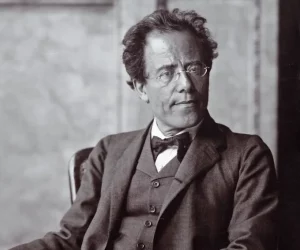I haven’t gone to movies much since the pandemic, which is a shame. Pre-pandemic, they were a delicious escape into another world, that I simply couldn’t duplicate in any other way, certainly not while watching Netflix in my living room, everyday life fibrillating all around me. But it’s Academy Award season, and I knew I had to try just a little. A film starring Cate Blanchett, set in the classical music world, garnering six Oscar nominations, available via streaming? Not one to miss.
Tár begins with a black screen and curious non-classical music—a lone voice singing. Turns out it’s a song, or ikaro, sung by shaman Elisa Vargas Fernandez from Peru’s indigenous Shipibo-Conibo culture, and yes, this is relevant to the story, although I ask you, how many viewers are going to figure this out? As too-tiny-to-read credits in white spool up the black screen, it’s a flashback to an earlier era, one of credits at the beginning of a movie again. I think they stopped doing this because viewers got bored, restless. It was a good reason.
“I wanted to recalibrate the viewer’s expectations about hierarchy,” writer-director Todd Field has explained. He’s equally unapologetic about the curious singing from an obscure indigenous culture. “Whether [the audience] understands what it is or not, I think it’s important just in terms of sort of saying, ‘Get ready, the rhythm and hues that you’re used to perhaps may be a bit different going forward,’ and intentionally try to put an audience on their heels and make them decide where they stand and if they stick with it or not. And it is disorienting, but intentionally so.”
Apparently Focus Features, the film’s distributor, wondered aloud that it might prove to be too disorienting, and thank you, Focus Features, you raised an excellent point. But writer-directors will be writer-directors, and in the end, Field’s choice prevailed.
Gotta admit that as it spooled on and on, I took the opportunity to leave the living room and start emptying the dishwasher (recalibrate that, Todd), returning only when the opening scene commenced, with its own challenges. We hear lots of words, essentially a spoken bio, about the main character, Lydia Tár, legendary conductor and all-around superstar of the classical music world. Turns out it’s an interview before a live audience at a New Yorker festival, where host Adam Gopnik, a real-life New Yorker writer, playing himself, describes her accomplishments and finally we see him and Lydia onstage, where they talk about her life, her extensive accomplishments, including an ethnomusicology stint where she spent several years living amid Peru’s indigenous Shipibo-Conibo culture (and see? I told you the opening song, that Lydia herself recorded, was relevant). This interview went on and on, and while I, a longtime classical music devotee, was interested enough, I uneasily glanced over at my husband, wondering if he was going to fall into a coma of boredom over this dry movie. I couldn’t help thinking, as well, that this was a film that audiences were going to love or hate, and in regards to the latter category, I hoped they didn’t associate classical music with this wordy, rambling opening scene. Or maybe, I decided, I was misjudging the movie’s audience, and that people were genuinely interested in learning more about what makes a world-class composer, particularly a female, particularly a highly accomplished one, tick. (For the record, Rotten Tomatoes gives the film a score of 91% from 324 critics and 71% from 250 verified audience ratings.) Further, the movie had one big thing going for it, besides the irresistible (to me) setting of the performing-arts world.
That would be Academy Award-winning Cate Blanchett, who plays Lydia Tár. She owns this movie. She’s up, once again this year, for Best Actress, and I’ve a strong hunch she’ll win it, because she is stunning. (Um, full disclosure, I haven’t seen any of the other nominated actresses or films, so, I have no grounds for my choice, except that, hey, Blanchett was really, really good.)
I hate writing synopses, so if you want to know in detail what the movie’s about, go somewhere else. Reviews and articles abound; I think I’ve read over thirty in the past two days alone. Everyone’s talking about this movie. In a nutshell, Tár, set in the international classical-music world, is about a female conductor, at the top of her game, her power, on the cusp of completing recordings of the full cycle of Mahler symphonies, but a few secret missteps from her past arise and soon threaten all she’s built up. Oh, and spooky things happen.
Here’s a peek.
My verdict? I loved the movie. I disliked the movie. I loved the classical music inclusion and the behind-the-scenes look at that world. I hated the choppiness of the short, mysteriously significant vignettes. I admired the artfulness of them. Much of the movie’s last quarter puzzled and thus annoyed me. But afterward, I couldn’t stop thinking about it. Unfathomably, I wanted more.
It’s like that Asian fruit, durian, that’s so horrible it’s irresistible, with its foul smell ranging from skunky, decaying fruity, to gym socks dipped in turpentine and left to dry out over two onion halves pulled from last week’s trash. You recoil in disgust but curiosity propels you to try it. At which time you recoil again. But then, unfathomably, you go back to it, because, as it turns out, “irresistible” doesn’t involve just pleasure. There’s a little torture in the equation. In spite of your discomfort, you feel compelled to return. You can’t not. And so you return.
I watched the movie a second time.
I can’t figure out how to classify Tár. A [very] subtle psychological thriller? A tale that flirts with #MeToo and cancel culture? A statement about power and the perils when it goes unchecked? An art-house film? A mystery? (Yup. I was mystified, all right.) Regardless, the film has garnered several Academy Award nominations: for Best Picture, Best Director, Best Actress, Best Original Screenplay, Best Cinematography, and Best Editing. That, and the fact that it’s set in the classical music world, features snippets of Mahler’s Symphony No. 5 (alas, not nearly enough), and that you can watch it in the comfort of your own home, should be all the reason you need to go see the film.
So go watch it.
But I feel compelled to close with the movie’s other star conductor/composer, which would be Gustav Mahler, and his Symphony No. 5. It’s glorious. It’s partly what drew me to the movie, and I’m grateful Field chose to include it. Although, in the movie, Mahler’s Symphony No. 5 here is depicted, in some ways as being the edgiest, most challenging of the symphonies—why, otherwise, did Lydia wait to record it last after she and her orchestra, a fictionalized Berlin Philharmonic (actually the Dresden Philharmonic), have recorded the other Mahler symphonies? One of the snippets in the film, during rehearsal, make it sound explosive, violent, shocking. Yes, there is That Moment in the symphony. But otherwise, that’s really not the case with Symphony No. 5, which is extremely listenable. (His symphonies No. 6 and 9, in my opinion, are the stormier ones.) There’s a nub of the “Adagietto” movement in the film, and thank goodness for that. Regular readers will know that it’s a huge favorite of mine, on lists like “10 somber classical tunes for a pandemic” and “Music for Grace — A Top 10 playlist for dying“.
Go watch the movie. Tell me what you thought of it. I’d love to chat with others who’ve seen it, whether they liked it, hated it, felt confused, bored, uneasy, restless, transported. Et cetera. It’s a movie that holds lots of Easter eggs (a term that describes those little “aha” nubs in a movie or video game that cleverly, and quickly, connects to a theme or story point) and the more I read up about the film and rewatch scenes via YouTube, the more I find. (The YouTube blog, Heavy Spoilers, offers a great, highly recommended analysis HERE.)
And give Mahler’s Symphony No. 5 a listen. It’s sublime.
And HERE is an article worth reading, NPR’s “Deceptive Cadence” chats with conductor Rafael Payare and poses the question, “Does Tár tell us anything about Mahler’s 5th symphony?”
And okay, HERE is an in-depth review from Phoebe Chen at The Nation that’s worth a read for some deeper insight into the movie and the character of Lydia.



Well, heck I just saw the part was originally written for a guy – along with the Oscar winner! That changes the whole thing. Feels like smarmy patronizing pandering to pop tropes of the moment to me, but that always sells – then disappears. Pop today, gone tomorrow.
I am all for keeping with the creator’s original vision, eg, West Side Story as a gay guy love story, etc. Anything that touts great work of the past I am for.
Thanks for the long essay – who does that anymore?
Speaking of mad, baffling [maybe] genius, I can’t figure out what you’re talking about, Kevin!
But hey. Glad you liked reading the essay and I agree, the “long essay” is a dying art. But not here at the Classical Girl! Always been one to buck trends, for better or worse. And thanks for sharing your [puzzling] thoughts.
From the moment the first few notes of the Icaro “cura mente” (Heal mind) I was riveted and knew i was about to watch something very different. The connection to the Shipibo traditions, ceremony, the ego as illness, ego/death, shamanic energy, and Ayahuasca visions were carefully woven throughout the script — as well as lydia tar’s character and her spiraling journey — in a complex and integral manner, similar to the Shipibo patterns that appeared in many of the scenes (the book, the metronome, Petra’s clay sculptures) It was in no way a cavalier off-hand detail of her back story written by some careless hack but by none other than Todd Fields, who I surmise is intimate with “The Medicine” himself, as only one so familiar with the Ayahuasca/Shipibo tradition could write such an accurate allegory of the arc of healing that the medicine and songs can give us.
There were so many other layers to the story of course — music theory, cultural ethics, psychology, the paranormal- and each facet no doubt inspires many different interests and perspectives. I’m happy to read that the movie has haunted as many as it has me, and equally, I’m not surprised it has turned so many away.
Absolutely LOVE your comments, CJ! Thanks so much for taking the time to share them. Very cool that the Shipibo tradition incorporates Ayahuasca. Wow, that changes a LOT in my mind. I’ve heavily researched Bwiti and iboga in Gabon (where I lived for 2 years) which seems to be Ayahuasca’s African equivalent. Wow. I’m going to have to watch the movie again, now, and revel in all the symbolism and connections to Ayahuasca visions and ceremonies. Soooo cool. Again, thanks for sharing!
What a weird film.
LOL,Hoover, I’ll give you that! But my question for you now is, good-weird, or just head-shaking weird?
And I realize it could be both!